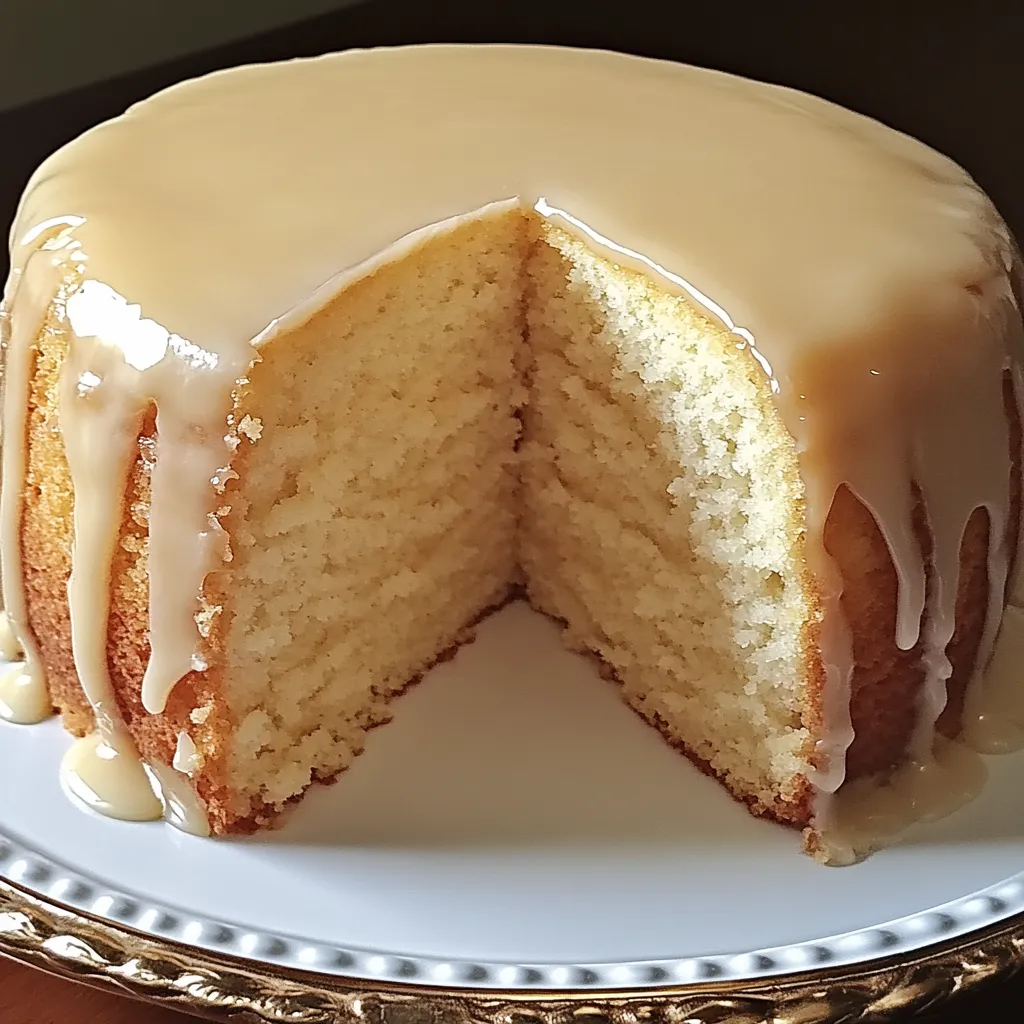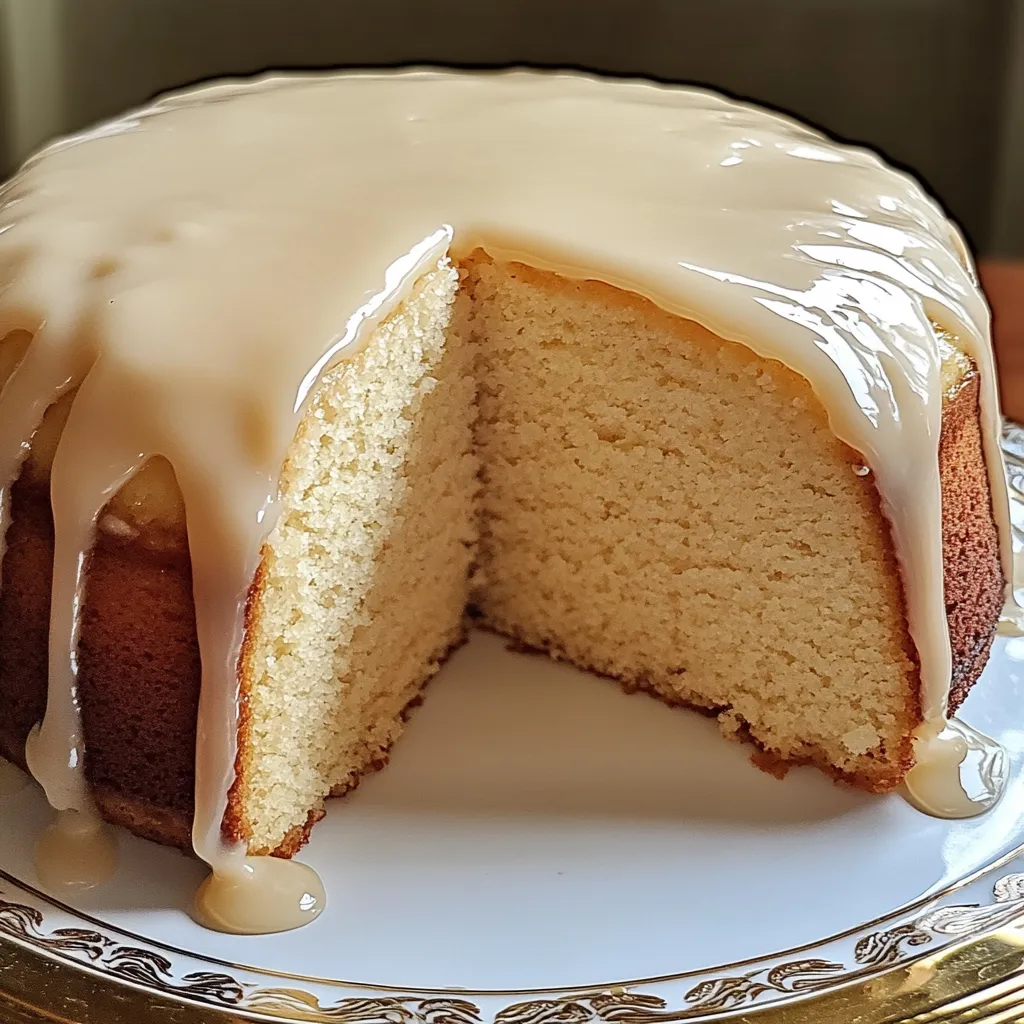 Pin
Pin
Velvety interior wrapped in a crispy golden exterior pairs perfectly with zingy cream cheese topping in this next-level twist on traditional pound cake. The magic comes from cultured buttermilk that makes it incredibly soft while adding just enough tang to match the warm vanilla running throughout. Each piece shows off a silky center that's somehow both rich and light—exactly what you need to soak up the creamy cheese topping that runs down the edges and gathers in yummy little pools around your serving.
I took this cake to my mother-in-law's birthday party last year, totally scared I couldn't match her amazing baking. When she quietly asked me for the recipe and later told me she'd made it three times in the next month, I knew I had something special. Mixing buttermilk in the batter with cream cheese in the topping creates this amazing flavor combo that makes it way better than regular vanilla cake.
Essential Ingredients
- All-purpose flour (3 cups): The proteins in all-purpose flour give you the right mix of structure and softness; spoon it into cups and level off for best results
- Baking powder (1 teaspoon): Adds just the right amount of lift while keeping the cake properly dense; make sure it's fresh
- Salt (1/2 teaspoon): Boosts all the other flavors and balances the sweetness; fine sea salt works better than regular table salt
- Unsalted butter (1 cup, softened): Forms the rich base for flavor and texture; fancy European butter with extra fat makes it even better
- Granulated sugar (2 cups): Adds sweetness and creates tiny air bubbles when mixed with butter; finer sugar blends in more easily
- Large eggs (4, room temperature): Give richness, structure, and help everything mix together; warm eggs trap more air when beaten
- Vanilla extract (2 teaspoons): Adds warm, sweet flavor throughout; real extract tastes much better than fake stuff
- Buttermilk (1 cup, room temperature): Makes the cake tender and adds slight tanginess; full-fat cultured buttermilk tastes best and keeps things moist
- Cream cheese (4 ounces, softened): Creates the tangy topping base; full-fat kind makes the smoothest texture
- Powdered sugar (1 1/2 cups): Melts completely for a smooth topping; sift it first to get rid of lumps
Making Magic
- Oven Preparation:
- Heat your oven to 325°F (160°C) with the rack in the middle. This lower temperature lets the cake bake slowly and evenly, which is key for good pound cake texture. Coat a 10-inch bundt pan thoroughly with butter or shortening, then dust with flour and tap out the extra.
- Dry Mix Assembly:
- Mix flour, baking powder, and salt in a medium bowl until they're well combined. This spreads the rising power and flavor evenly through the batter. You can sift everything to make the cake even lighter by getting rid of any clumps.
- Butter Transformation:
- Beat the softened butter in a large bowl or stand mixer with the paddle attachment until it's creamy and lighter in color, about 1 minute. Properly softened butter should dent slightly when you press it but still keep its shape.
- Sugar Incorporation:
- Slowly add sugar to the butter while beating at medium speed for a full 5-7 minutes until the mixture gets much lighter in color and fluffier in texture. This long mixing creates millions of tiny air bubbles that give your cake its fine texture.
- Egg Addition:
- Add eggs one at a time, beating for 30 seconds after each one until it's fully mixed in. Scrape the bowl sides often to mix everything evenly. Don't worry if the mixture looks a bit curdled after adding eggs—that's normal and will smooth out.
- Flour and Buttermilk Integration:
- Turn mixer to low speed and add dry ingredients in three batches, alternating with buttermilk in two batches, starting and ending with flour. Mix each addition just until it disappears, being careful not to overmix which would make the cake tough.
- Pan Transfer:
- Spoon the batter into your prepared bundt pan and smooth the top with a spatula. Tap the pan firmly on the counter several times to pop any air bubbles that might create holes in your finished cake. The thick batter should fill about two-thirds of the pan.
- Baking Process:
- Bake in your preheated oven for 55-65 minutes until golden brown and a wooden pick stuck in the center comes out clean or with just a few moist crumbs. Don't open the oven during the first 45 minutes or temperature changes might make the cake fall.
- Cooling Stage:
- Let the cake cool in the pan on a wire rack for exactly 10 minutes—this timing matters because too short causes breaking, too long causes sticking. Flip it onto the rack to cool completely before adding topping, which might take 2-3 hours.
- Glaze Creation:
- Beat softened cream cheese in a medium bowl with an electric mixer until completely smooth with no lumps, about 2 minutes. Properly softened cream cheese should yield easily when pressed gently. Gradually mix in sifted powdered sugar and vanilla extract on low speed until combined, then increase to medium speed until smooth and fluffy. Add milk or cream one tablespoon at a time while mixing until the topping reaches the right thickness—it should stick to the cake but still flow down the sides nicely. For thicker topping, use less liquid; for thinner, use more.
- Final Assembly:
- Put your completely cooled cake on a serving plate with edges to catch extra topping. Pour or spoon the topping over the cake, letting it naturally flow down the sides. For more control, use a piping bag with a round tip.
 Pin
Pin
My grandma always told me pound cake isn't just about what goes in it—it's about patience. 'You can't rush the creaming,' she'd remind me as I fidgeted by the mixer. She was spot on. Watching butter and sugar change from gritty to fluffy sets the stage for everything else. Whenever I'm tempted to cut this step short, I think about how her cakes always had that amazing, silky texture mine couldn't match until I learned to give those ingredients their full five minutes to work together.
Tasty Serving Ideas
This go-to cake works beautifully in many different settings. For morning meals, try thick slices lightly toasted with a smear of salted butter and some fresh berries on the side. During summer get-togethers, pair slices with juicy strawberries and fresh whipped cream for a fancy take on strawberry shortcake. When holidays roll around, top with sugared cranberries and mint for a festive look. At dinner parties, serve individual pieces with a light dusting of powdered sugar and a small scoop of vanilla bean ice cream.
Fun Flavor Twists
Change up this flexible base recipe to match different seasons throughout the year. If you love citrus, mix in two tablespoons of lemon, orange, or lime zest to the batter and swap vanilla for matching citrus juice in the topping. For a fall-friendly version, add 1 teaspoon of cinnamon, 1/2 teaspoon of nutmeg, and 1/4 teaspoon of cloves to your dry ingredients. Coffee fans can mix 2 tablespoons of espresso powder into the buttermilk for a gentle coffee flavor that works really well with the cream cheese topping. Stir in 1/2 cup of finely chopped nuts or 2 tablespoons of poppy seeds to add interesting texture and flavor layers.
Storage Solutions
Keep your cake tasting amazing with these storage tricks. Store cake without topping at room temperature in an airtight container up to 3 days, with parchment between layers to prevent sticking. For longer freshness, keep it in the fridge in a cake container for up to a week, but let it warm up before serving for best taste and texture. This cake freezes really well—wrap single servings in plastic wrap, then foil, and freeze up to 3 months. Thaw overnight in the fridge before letting it sit at room temperature about an hour, or warm slightly in a 300°F oven for 5-10 minutes to make it taste freshly baked.
This vanilla buttermilk pound cake has totally changed how I feel about pound cakes. What started as just trying something new has become a regular at my dinner table—showing how simple ingredients handled with care can make truly unforgettable food. The way the cake's gentle vanilla sweetness plays against the tangy cream cheese topping creates something way better than you'd expect. Even friends who usually pass on dessert have been won over after trying a slice.
 Pin
Pin
Recipe Questions & Answers
- → What does buttermilk do in this recipe?
- It makes the cake moist, soft, and adds a slight tang. Its acidity also boosts the cake’s rise while balancing sweetness.
- → Can I bake this cake without a bundt pan?
- Sure! Swap it for two loaf pans (9×5 inches). Fill them partially, bake around 45–55 minutes, and test with a toothpick—it should be clean.
- → Why does my cake have a crack?
- Totally normal! It happens as the cake cooks, and the dome rises. Many see it as a hallmark of pound cake, and the frosting covers it anyway.
- → How do I check if the cake is ready?
- Use a toothpick—poke the center, and it should come out almost clean. The cake edges will pull back from the pan lightly.
- → Can I switch up flavors in this cake?
- Of course! Try orange or lemon zest, almond extract, a pinch of cinnamon, or fold in floured berries for fun variations.
- → What's the best way to store leftovers?
- Keep unglazed cake wrapped at room temp for 3 days. If glazed, refrigerate up to 5 days. Let it sit out for best flavor before eating.
